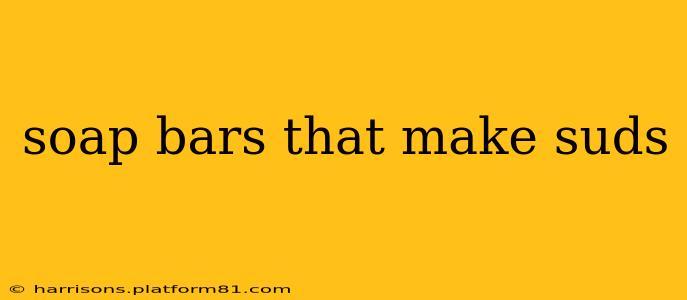Finding a soap bar that produces a luxurious, abundant lather is a quest many soap enthusiasts undertake. While all soaps clean, the richness of the lather significantly impacts the overall cleansing experience. This guide delves into the factors influencing sudsy soap bars, helping you choose the perfect one for your needs.
What Makes a Soap Bar Suds Up?
The key to a sudsy soap lies in its ingredients and manufacturing process. Several factors contribute to the amount of lather produced:
-
Soap Base: The type of oil or fat used in the saponification process (the chemical reaction that creates soap) heavily impacts lather. Oils like coconut oil and palm kernel oil are known for their high lathering properties due to their high levels of lauric and myristic acids. Conversely, olive oil, while producing a gentle soap, is less prone to creating copious suds. A blend of oils often provides a balance between lather and other desirable qualities like moisturizing properties.
-
Superfatting: This refers to the amount of unsaponified oil left in the soap after the saponification process. A higher superfat percentage generally leads to a creamier, more moisturizing bar but often reduces lather. Lower superfatting tends to increase lather.
-
Additives: Certain additives, like glycerin (naturally occurring in soapmaking but often added), can influence lather. Glycerin is a humectant, attracting and retaining moisture, which can affect the texture and sudsiness of the soap. Other additives, such as essential oils or clays, might slightly alter the lather depending on their properties.
-
Manufacturing Process: The manufacturing process itself can affect the final product's lather. The way the soap is mixed, poured, and cured can influence its density and ability to produce suds.
What Types of Soap Bars Produce the Most Suds?
Many soap types excel at producing a rich lather. Here are some popular choices:
-
Castile Soap: Castile soap, traditionally made from olive oil, often produces a moderate lather. However, modern castile soaps may include other oils like coconut oil, significantly boosting their sudsiness.
-
Coconut Oil Soap: Soaps primarily made with coconut oil are renowned for their exceptional lather. They create copious, fluffy bubbles.
-
Combination Oil Soaps: Many soapmakers blend different oils to achieve the perfect balance between lather, moisturizing properties, and cleansing ability. These combinations often provide excellent suds while maintaining skin-friendly qualities.
How Can I Make My Soap Bar Sudsier?
While you can't dramatically change the lather of an existing soap bar, you can influence its sudsiness in use:
-
Water Temperature: Using warmer water helps activate the soap's lathering properties.
-
Soap Usage: Use a generous amount of soap and work it between your hands or a washcloth to create a good lather.
Are High-Sudsing Soaps Better for My Skin?
The level of sudsiness doesn't directly correlate with a soap's effectiveness or gentleness. While abundant lather might feel luxurious, it doesn't necessarily indicate superior cleansing power or skin-friendliness. Some people with sensitive skin may find that overly lathery soaps can be drying. Always consider your skin type and preferences when choosing a soap bar.
Do All Soap Bars Need to Be Highly Sudsy?
Absolutely not! Many soapmakers prioritize other qualities like moisturizing properties or gentle cleansing for sensitive skin. A less sudsy soap can be just as effective and even more beneficial for certain skin types. The best soap is the one that works best for you.
What are some alternatives to traditional soap bars that produce lots of suds?
While this article focuses on soap bars, it's worth mentioning that liquid body washes generally produce more suds than solid soap bars. This is often due to added surfactants and the inherent nature of the liquid formula. However, many prefer the sustainability and simplicity of soap bars.
By understanding the factors that influence lather, you can make informed decisions when choosing a soap bar that perfectly meets your needs and preferences, whether you crave abundant suds or prefer a gentler, less lathery cleansing experience.
